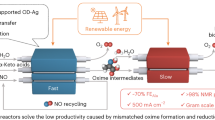Abstract
Objective
The construction of a novel bioanode based on l-proline oxidation using a cascade reaction pathway comprised of thermostable dehydrogenases.
Results
A novel multi-enzymatic cascade pathway, containing four kinds of dehydrogenases from thermophiles (dye-linked l-proline dehydrogenase, nicotinamide adenine dinucleotide (NAD)-dependent Δ1-pyrroline-5-carboxylate dehydrogenase, NAD-dependent l-glutamate dehydrogenase and dye-linked NADH dehydrogenase), was designed for the generation of six-electrons from one molecule of l-proline. The current density of the four-dehydrogenase-immobilized electrode, with a voltage of + 450 mV (relative to that of Ag/AgCl), was 226.8 μA/cm2 in the presence of 10 mM l-proline and 0.5 mM ferrocene carboxylate at 50 °C. This value was 4.2-fold higher than that of a similar electrode containing a single dehydrogenase. In addition, about 54% of the initial current in the multi-enzyme cascade bioanode was maintained even after 15 days.
Conclusions
Efficient deep oxidation of l-proline by multiple-enzyme cascade reactions was achieved in our designed electrode. The multi-enzyme cascade bioanode, which was built using thermophilic dehydrogenases, showed high durability at room temperature. The long-term stability of the bioanode indicates that it shows great potential for applications as a long-lived enzymatic fuel cell.



Similar content being viewed by others
References
Adams MW (1993) Enzymes and proteins from organisms that grow near and above 100 degrees C. Annu Rev Microbiol 47:627–658
Akers NL, Moore CM, Minteer SD (2005) Development of alcohol/O2 biofuel cells using salt-extracted tetrabutylammonium bromide/Nafion membranes to immobilize dehydrogenase enzymes. Electrochim Acta 50:2521–2525
Arechederra RL, Treu BL, Minteer SD (2007) Development of glycerol/O2 biofuel cell. J Power Sources 173:156–161
Cosnier S, Le Goff A, Holzinger M (2014) Towards glucose biofuel cells implanted in human body for powering artificial organs. Electrochem Commun 38:19–23
Inagaki E, Takahashi H, Kuroishi C, Tahirov TH (2005) Crystallization and avoiding the problem of hemihedral twinning in crystals of Δ1-pyrroline-5-carboxylate dehydrogenase from Thermus thermophilus. Acta Crystallogr F 61:609–611
Inagaki E, Ohshima N, Takahashi H, Kuroishi C, Yokoyama S, Tahirov TH (2006) Crystal structure of Thermus thermophilus Δ1-pyrroline-5-carboxylate dehydrogenase. J Mol Biol 362:490–501
Kujo C, Sakuraba H, Nunoura N, Ohshima T (1999) The NAD-dependent glutamate dehydrogenase from the hyperthermophilic archaeon Pyrobaculum islandicum: cloning, sequencing, and expression of the enzyme gene. Biochim Biophys Acta 1434:365–371
Li WF, Zhou XX, Lu P (2005) Structural features of thermozymes. Biotechnol Adv 23:271–281
Ohshima T, Soda K (1989) Thermostable amino acid dehydrogenases: application and gene cloning. Trends Biotechnol 7:210–214
Palmore GTR, Bertschy H, Bergens SH, Whitesides GM (1998) A methanol/dioxygen biofuel cell that uses NAD+-dependent dehydrogenases as catalysts: application of an electro-enzymatic method to regenerate nicotinamide adenine dinucleotide at low overpotentials. J Electroanal Chem 443:155–161
Sakamoto H, Uchii T, Yamaguchi K, Koto A, Takamura EI, Satomura T, Sakuraba H, Ohshima T, Suye SI (2015) Construction of a biocathode using the multicopper oxidase from the hyperthermophilic archaeon, Pyrobaculum aerophilum: towards a long-life biobattery. Biotechnol Lett 37:1399–1404
Sakamoto H, Komatsu T, Yamasaki K, Satomura T, Suye SI (2017) Design of a multi-enzyme reaction on an electrode surface for an l-glutamate biofuel anode. Biotechnol Lett 39:235–240
Satomura T, Hara Y, Suye S, Sakuraba H, Ohshima T (2012) Gene expression and characterization of a third type of dye-linked l-proline dehydrogenase from the aerobic hyperthermophilic archaeon, Aeropyrum pernix. Biosci Biotechnol Biochem 76:589–593
Satomura T, Hayashi J, Sakamoto H, Nunoura T, Takaki Y, Takai K, Takami H, Ohshima T, Sakuraba H, Suye SI (2018a) d-Lactate electrochemical biosensor prepared by immobilization of thermostable dye-linked d-lactate dehydrogenase from Candidatus Caldiarchaeum subterraneum. J Biosci Bioeng 126:425–430
Satomura T, Hayashi J, Ohshida T, Sakuraba H, Ohshima T, Suye S (2018b) Enzymological characteristics of a novel archaeal dye-linked d-lactate dehydrogenase showing loose binding of FAD. Extremophiles 22:975–981
Tonooka A, Komatsu T, Tanaka S, Sakamoto H, Satomura T, Suye S (2018) A l-proline/O2 biofuel cell using l-proline dehydrogenase (LPDH) from Aeropyrum pernix. Mol Biol Rep 45:1821–1825
Xu S, Minteer SD (2011) Enzymatic biofuel cell for oxidation of glucose to CO2. ACS Catal 2:91–94
Zhu Z, Sun F, Zhang X, Zhang YH (2012) Deep oxidation of glucose in enzymatic fuel cells through a synthetic enzymatic pathway containing a cascade of two thermostable dehydrogenases. Biosens Bioelectron 36:110–115
Zhu Z, Tam TK, Sun F, You C, Zhang YHP (2014) A high-energy-density sugar biobattery based on a synthetic enzymatic pathway. Nat Commun 5:3026
Acknowledgements
We thank Ms. Yumi Sugamura for technical assistance. We would like to thank Editage (www.editage.jp) for English language editing.
Supplementary information
Supplementary Figure 1—SDS-PAGE of purified enzymes making up the l-proline multi-step oxidation pathway. A, Ap-LPDH; B, ThP5CDH; C, GkNADHDH; D, Pi-GDH; M, protein marker; E, purified enzyme.
Author information
Authors and Affiliations
Corresponding author
Ethics declarations
Conflict of interest
The authors declare that they have no competing interests.
Additional information
Publisher's Note
Springer Nature remains neutral with regard to jurisdictional claims in published maps and institutional affiliations.
Electronic supplementary material
Below is the link to the electronic supplementary material.
Rights and permissions
About this article
Cite this article
Satomura, T., Horinaga, K., Tanaka, S. et al. Construction of a novel bioanode for amino acid powered fuel cells through an artificial enzyme cascade pathway. Biotechnol Lett 41, 605–611 (2019). https://doi.org/10.1007/s10529-019-02664-8
Received:
Accepted:
Published:
Issue Date:
DOI: https://doi.org/10.1007/s10529-019-02664-8




